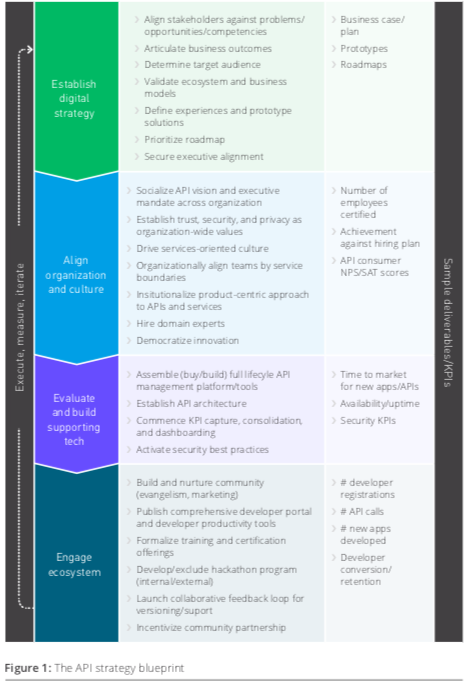API Strategy Resources
An API strategy is a critical component of digital transformation. Over the years, the term “API” (which stands for Application Programming Interface) has been used generically to describe a connectivity interface to an application. However, modern APIs have taken on some characteristics that distinguish them from poorly designed APIs of the past:
- Modern APIs adhere to standards (typically HTTP and REST), that are developer-friendly, easily accessible and understood broadly.
- They are treated more like products than code. APIs are designed for consumption for specific audiences (e.g., mobile developers), they are documented, and they are versioned in a way that users can have certain expectations of its maintenance and lifecycle.
- Because they are much more standardized, today's APIs have a much stronger discipline for security and governance, as well as monitored and managed for performance and scale.
When an organization strategically envisions APIs as engines for new products, new business channels, and new business models in ways that ultimately produce new revenue or other measurable value, that organization is said to be monetizing its APIs. In aggregate, the organizations around the world that directly or indirectly monetize their APIs form the basis of what the media often calls the “API economy.” As a subset of the total global economy, the API economy is annually responsible for the exchange of trillions of dollars.
Taken together, an organization, its platform of APIs, the channels of platform availability, and the various constituencies to which those APIs are available (internal developers, external developers, partners, customers, and more) can form a thriving ecosystem.
API strategy blueprint
The API strategy blueprint is very pragmatically broken down into four stages. Each stage represents a collection of critical business and technological fundamentals easily tackled by committed organizations who have the necessary executive backing and long-game patience.
The four stages of an API strategy are:
- Establish digital strategy
- Align organization and culture
- Evaluate, build, and deploy supporting technology
- Engage your ecosystem
The key components of an API strategy
MuleSoft is the only company that offers a unified solution for composition, API management, and connectivity. Anypoint Platform, MuleSoft’s flagship product, has all the pieces of the enterprise agility puzzle. Get started on defining, creating, and maintaining your organization’s API strategy:
Designing and building modern APIs
The modern API, also known as the API building block, consists of functionality and simplicity required for the full lifecycle of APIs, connectivity to any source of data, ability to compose the data, and provides full visibility, security, governance right from design. You can’t execute on an effective API strategy without having well-designed APIs
- What is an API?
- What is API Management?
- What is Custom Code?
- Type of APIs
- How to Design and Manage APIs
- What is API testing?
- What is REST API Design?
- API Development Best Practices
- A Guide to Designing the Perfect API
- The Importance of API Documentation
- Secrets of a Great API
- API-First Development with RAML and SoapUI
- The API Love Triangle: Delivering Successful API Programs
- API Security by Design
- What is GraphQL?
Managing APIs throughout their full lifecycle
The modern API is a product and it has its own software development lifecycle (SDLC) consisting of design, test, build, management, and versioning. It also comes with thorough documentation to enable its consumption.
Managing APIs throughout their entire lifecycle is critical to achieving an API strategy’s power to affect digital transformation.
- Gartner’s Magic Quadrant for Full Lifecycle API Management,
- Managing the Full API Lifecycle
- API Management for Product Managers
- 7 Habits of Effective API and Service Management
Developing your organization’s API strategy
Building great APIs must go hand-in-hand with using them to develop our recommended API strategy, API-led connectivity. Here’s how to get started:
- API-led Connectivity: The Next Step in the Evolution of SOA
- So You Want to Develop an API Strategy. Now What?
- Best Practices for Microservices
- What is Agile Project Development?
- The Application Network
Benefits of having a well-defined API strategy
When our customers adopt an API strategy, they experience dramatic and positive business outcomes. Here are real-world case studies of how our customers achieved digital transformation with our recommended API strategy.
- API strategy essentials: a practical guide to winning in the API economy
- What is an API Economy
- The Rising Value of APIs
- How Our Customers Get it Done Faster
- Case Study: Cox Automotive
- Case Study: Dixons Carphone





